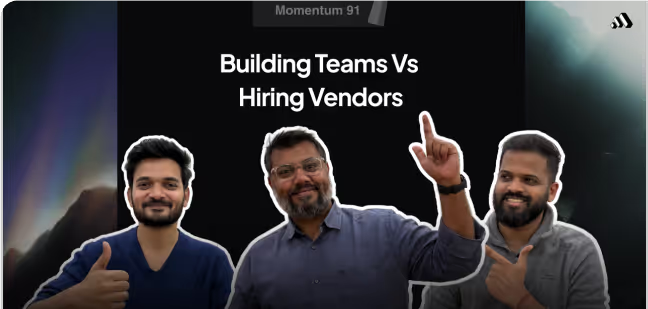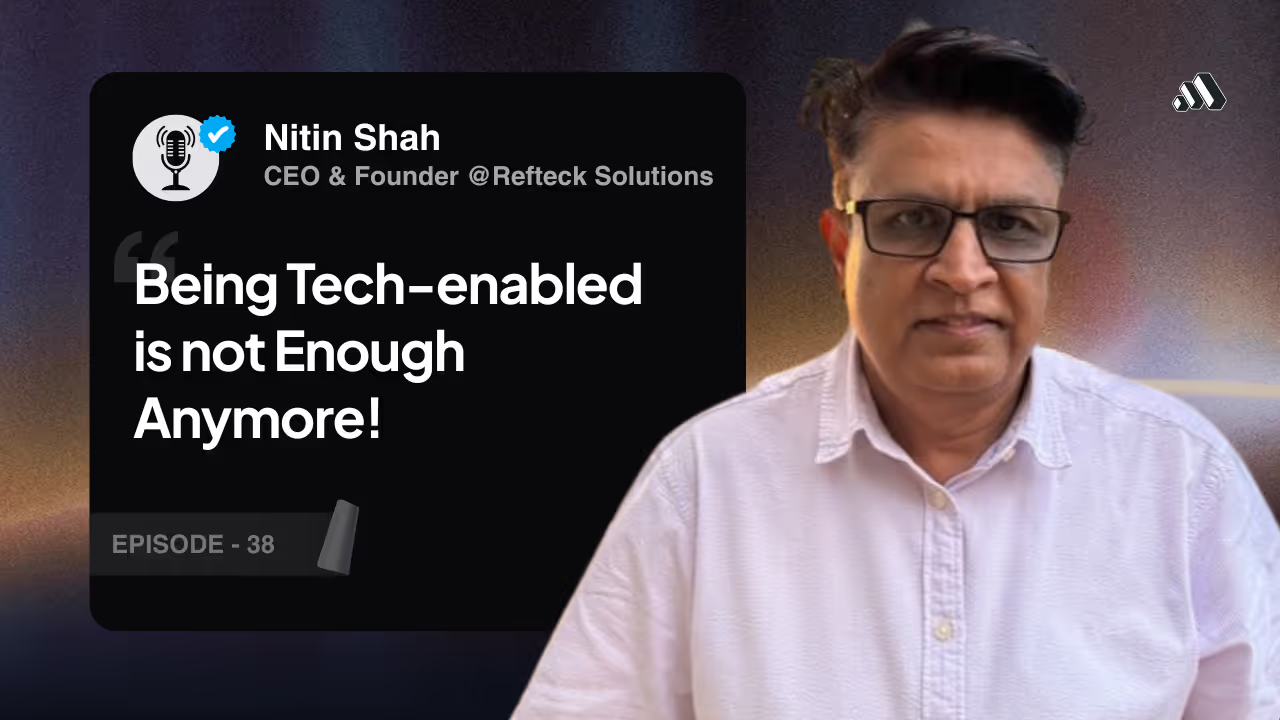Story from being an engineer to a SaaS entrepreneur




.avif)
Introduction
In this episode, Yash interviews Sander from Social Juice, a platform that helps businesses collect and showcase video testimonials. They discuss the challenges of collecting high-quality reviews, the transition from being a front-end engineer to an entrepreneur, and the importance of balancing product development with marketing efforts. Sander shares his insights on measuring success, choosing an ideal client persona, and determining when to stop investing in certain acquisition channels. The conversation highlights the importance of customer-centricity and the pursuit of a better quality of life as a founder.
"Don't fall into the default trap of spending 99% of the time on the product and 1% on spreading the word."
- Sander Belaen
Key Takeaways
- Social Juice helps businesses collect video testimonials to build trust and engage customers.
- Balancing product development with marketing efforts is crucial for success.
- Transitioning from a front-end engineer to an entrepreneur requires focusing on customer needs and spreading the word about the product.
- Measuring success in terms of accounts created, trials started, and testimonials collected provides valuable insights.
- Choosing an ideal client persona involves considering customer acquisition cost, lifetime value, and market demand.
- Determining when to stop investing in certain acquisition channels requires careful analysis of results and iteration.
- Prioritizing a better quality of life as a founder can guide decision-making and business growth.
Transcript
Yash From Momentum (00:02)
where we peel back the curtain on the exciting and often chaotic world of building successful SaaS business. I'm Yash, your host for this show, where every episode we bring to you the stories and strategies of founders who've been in the trenches, conquering churn, scaling their teams, and building products that people and businesses love. In this episode, we'll be chatting with Sander from Social Juice. Social Juice helps businesses collect testimonials from their customers and showcase them in a beautiful and impactful way.
We're excited to hear their story and the lessons that they've learned along the way. We'll be dissecting the wins, the losses, and everything in between. So buckle up, grab your headphones, and get ready to dive in the world of SaaS. Hey, hi, Sander. Thank you for joining in. How are you doing?
Sander Belaen (00:46)
Wow, what a lovely introduction. Thanks for having me. I'm doing very well. How about yourself?
Yash From Momentum (00:49)
Absolutely. I'm doing great as well. And since you've joined, I've started to do a little better. But I have a feeling this is going to be a great conversation, because most of the SaaS founders who we've had on the show before, the profile and the questions that I have for you are a little different, because most of them either have raised some capital or have some amount of team. The idea of this conversation is
for SaaS founders who are currently building a SaaS company to give advice and learnings in real time to other SaaS founders or agency owners who are looking to build their SaaS. So I have a feeling this will be a great conversation. So let's start with this. What is the big, bad problem for businesses that you're solving today?
Sander Belaen (01:35)
That's a good question. So what Social Juice does is it makes it incredibly easy for companies to collect reviews, but mainly video reviews from their customers. And the reason that's important is because no one nowadays really buys anything without checking reviews first. So companies really start noticing that, and they know they should take reviews seriously. So that's why every company has this section on their website that says, is what our clients say, and then there may be some text underneath that you
really know if you can trust it. So the main idea of social juice is you want to replace that with feature reviews because those work just work way better. You can trust them more. They're harder to fake. They're way more engaging if a smiling face is there talking positively about your business. But in practice, that's extremely hard to collect those testimonials, to collect those reviews. Like, how do you really ask? How do you expect the process to go if you don't have specific tooling for it? So
We've created a whole tool set to make that process as frictionless as possible, all the way from the collection part to getting it on your website without having to have any technical expertise about websites or anything.
Yash From Momentum (02:36)
So I've been running a business for about 10, 12 years now. Had an agency, built a SaaS, exited it. And this has been a consistent problem for our business. Even the most happiest of customers, when you ask them for reviews, they will give you something that might be very different than what you really needed from them. And they would feel
They tell the same things on chat. They tell the same things when you're doing their customer interviews to figure out what to build or how to offer a better service. But oftentimes, when you actually ask for a review, they either skip their mind or they'll not write it or they forget to say that in video. I also noticed on your website that you have
that you recently introduced AI as a part of the journey of collecting the videos, where AI will make sure that depending on the conversation, it asks the right questions to the customer so that you as a business actually get what you're looking for. Can you tell a little more about
Sander Belaen (03:28)
Exactly.
Yeah, of course. So it's exactly like you said, even though if people are very happy with their business and they are willing to leave a review, people still ended up with short and low quality reviews because they just didn't know what to talk about. And that's a shame because, again, they are willing to leave a review and they have positive things to say. So Social Juice AI suggests things to talk about. So for example, we had a great demo in the beginning with a barbecue company.
So it would ask, what did you make on the barbecue? For what occasion did you use it? And if you write a review and you said, using this barbecue was a great experience. It was easy to clean. I made smoked salmon for my birthday. That's already way more engaging and quality review. But you would have never come up with that yourself. So it really helps you to know what to talk about. And yeah, without actually.
introducing any fake review or anything. So it's an incredible way to introduce AI here. And the questions are generated by the AI, and that's determined by what the product is about. So they're always context aware. It's incredible, actually. It works really well.
Yash From Momentum (04:39)
One of the other things that I also interestingly noticed on your LinkedIn profile is that before this, were an engineer, a web developer, maybe, but a front -end engineer for sure. And this show is primarily consumed by very early stage SaaS companies or agencies who are looking to build SaaS products or, you know.
folks who are builders and are looking to start a technology -based business, some way where they can leverage their experience of building good products and get it to customers. What are your top couple of learnings moving? I think you've been running Social Juice for about over two years now. What are your learnings transitioning from a front -end engineer to becoming an entrepreneur and building and growing a SaaS company?
Sander Belaen (05:20)
I would say don't fall into the default trap of spending 99 % of the time on the product and 1 % on spreading the word. Because if you have the best product in the world and no one knows about it, no one knows it exists, then you don't have a business. And I know that everyone that hears it, like says, it sounds very intuitive, but it's still very easy to fall into it. And I've been guilty of that myself.
So I would say, really make a plan with, this is what I'm going to build. Ideally, you split up your time in two, and you build half of the time, you tell about what you built. You could talk about what you built in the previous time, and then you repeat that cycle. Yeah, so.
Yash From Momentum (05:59)
I would actually also say that this is knowing how to code or knowing how to build a good product in the early stage of a SaaS company is also a curse. And I say that with a lot of responsibility. So I'll tell you what. So when we started ClientJoy, which was a CRM for freelancers and agencies, I had a co -founder who knew how to build a great
from design to feature development, everything from start to finish. But I was a mechanical engineer, right? So I didn't know how to code. And since I didn't know how to code, and I had 10 hours a day, so my goals were always talking to 10 prospects this week or reaching out to 100 people this week, figuring out what the pricing should be, figuring out what that positioning should be, figuring out who our ideal customers are, and so on and so forth.
And I think that if I knew how to code, I would go to my comfort zone and aid my co -founder in either on the front end or back end or DevOps or testing or whatever that is. But this is true. And this has been consistent across all the podcasts that we've done. Whenever a builder has come on the show and have now become an entrepreneur, their first advice is talk to customers, talk to people, figure out ways to distribute and stuff like that.
So thank you for doubling down on that as well. So we'd love to understand, over the last couple of years at Social Juice, you must have tried a couple of different go -to -market channels and strategies. What are some of the things that have worked for you? What are some of the things that have not? If you can share a little bit around. before that, think actually we should try and take stock. So if you can share with us a little bit about
the size and scope of social juice as on data. And then we move to the next question because that will be a better way to give more context.
Sander Belaen (07:44)
Sure. Social Juice as a company, I don't have any people on payroll. It's just me and then people that I contract for sales and then sometimes design when it's needed, but I design most of myself. And then I recently have a content team that helps me with making content to spread on social media.
I'm very excited about this. The first videos are going to be live next week. So that's very new. But that's about the size of the company. And I really like it this way. I'm going to try to keep it like this as long as I can. And yeah, for customers, again, because it's a...
Yeah, it doesn't look as big on social media because I haven't been posting a lot, but we have at this point thousands of customers. We also have a pretty generous free tier, so it's very easy to start and see if it's something for you. And we notice that people that try it are very happy and yeah, they immediately see the value in Scrapable to see that.
Yash From Momentum (08:39)
Nice, yeah. Exciting to hear that. And so if we could talk about, so how did you reach to these thousands of customers? What were some GTM experiments or marketing experiments or growth experiments that you ran?
Sander Belaen (08:51)
Yeah, the first way I went live is the default way posting it everywhere. So on Product Hunt and on Reddit and on Hacker News and stuff. And that got a little bit traction. And then in the very early days, we did a lifetime deal as well. The product is very different now than it was back then. But that was a really good idea for us because we've got a lot of initial users.
a lot of initial feedback on how the product worked. then what that also brings is people that use social juice to collect reviews, they spread it out themselves in order to collect their reviews. So people that use it also spread the product. So we have that plus an affiliate program. And that made those happy customers that got in very early, even though the product wasn't
that good back then, they already started spreading it by using it as well as having the affiliate program. And that really got the ball rolling. And after that, it's very much more boring stuff like cold outreach via LinkedIn. people, yeah, really, really referrals, actually. That was a very big part of it.
Yash From Momentum (09:58)
Yeah, boring stuff actually makes for good business. So the more that the work is exciting, the lesser the ROI. So as an example for Clientjoy, we were serving close to about 13 ,000 -odd customers from 90 -odd countries who were using the product to manage about 78 ,000 of their clients and collect about 25 million in payments payments each month.
Sander Belaen (10:04)
Sadly.
Yash From Momentum (10:23)
And the one key channel that worked in our case was SEO. And it is extremely boring to build sustainable, repeatable traffic using SEO for the ICP that you want, who are ready to purchase, planning your content for top of the funnel, middle of the funnel, bottom of the funnel, and then just consistently military style execution. You question yourself, right? Because when you start, you typically think that this
is going to be an exciting business building journey. But that worked for us and that works a lot of times as well. So one of the other interesting things that you mentioned in the previous answer was that you don't have team members. You work with people on contract basis, depending on the thing that your organization needs at any point of time. And you would like to keep it that way.
So the first piece, I agree and I understand that when you start, you typically want to keep your costs low. You want to make sure that you become sustainable. But why keep it that way? So why not raise capital? Why not aggressively go all in? Why not build like a 50 million annual run rate? Why bootstrap? Why stay as lean? What's the thought process?
Sander Belaen (11:31)
Well, the thing I try to optimize for is quality of life. And I feel like the bigger this gets, the more freedom it gets. the moment you raise capital, it's really a stressful life again. And it's not clear to me that that would make my life better.
And in the end, if you're doing, if you are in any business at all, why are you doing it? feel like quality of life for me is the reason. yeah, again, if it's not clear to me that that would make it better, it would be quite the opposite. seems.
Yash From Momentum (11:58)
You have.
My job is to talk and I am not left speechless often. But this is a great answer and I tell you why. Because when I started my first company, I did not have the maturity to ask myself, is this going to improve my quality of life or
What do I want to do? So as a founder, you typically always want to offer value to your customers, returns to your investors, a great culture for your team members. So all the stakeholders, as a founder, you're trying to figure out and just work your like work 80 hour weeks to figure out how can you offer value and returns and culture and all of those things. You never forget. You never ask the question, what do I get? And why am I like, what's my purpose of running this as a business?
Interesting that you say that this is actually the thought process with my current business, with momentum. That's the idea. So I want to make sure that I do things that I love. yeah, so great points here. What are the other things that I wanted to ask you and understand is how do you measure
Sander Belaen (12:42)
He he.
Yash From Momentum (13:02)
the success of social juice. So what does a couple of key metrics that you measure on a month -on -month basis or a week -on -week basis internally for you to know whether this is working or this is not working. And it can be across product usage or customer feedback or any other metric that you measure, which essentially tells you last week was great. Let's do more of it more often this week.
Sander Belaen (13:26)
Yeah, I mean, those metrics are very straightforward. It's create accounts created, it's trials started and it's testimonials collected. And also when you create an account, can, I now added or a few months ago, you need to also input what your, where did you hear about social juice and what's your goal?
Like, that one isn't like, that's a good one actually. Like, what's your goal? So you can measure whether the people that make an account actually know what they're going to get. Like, are they here for what I have to offer, or do they think it's something else? And if it is something else, like, what's wrong there? Like, was your messaging wrong? So those two are very, good. But because you can also see the source, where did you hear about this?
how to come here. That's also a good way to see whatever you tried before, what is working and what
Yash From Momentum (14:17)
Fair point. I think measuring the metric that how much has our product impacted our customer's life, that's an interesting way to look at whether we've grown or not. So how many reviews have been collected? If that was higher this week than it was last week, then let's make it even higher coming week. This sort of brings us to the last.
piece of our conversation, which is where we ask you the question that our previous founder has asked you. And then I'll also need you to ask a question, like a question that you're battling with as of now at Social Juice for our next guest. So the question that I have for you from Lena from UnSchooler. UnSchooler is an LMS, a learning management system. And as a SaaS product, they have
Sander Belaen (14:53)
Mm -hmm. Yep.
Yash From Momentum (15:04)
multiple different ideal client personas, which exist and have very different behaviors than each other. So they could target an enterprise for an internal learning management system, or they could target coaches for creating an LMS for the people who are enrolled into their programs. And the way that coaches purchase a product versus the way that a large enterprise would purchase a product are very different. And even you need to have different things prepared on your side, your GTM.
will have to change and so on and so forth. When you have two different or three different ideal client personas that exist out there in the market for the product that you create, how do you choose which one to go after? So what do you look for? And I'm sure this is a challenge at social juice as well. Not necessarily a challenge and opportunity, but you still need to arrive at an ICP to go after. So what do you do? How do you think about this?
Sander Belaen (15:55)
Yeah, it's a very valid point. Certainly for social Jews, make review collecting easy. Like who needs reviews? Everyone needs reviews, right? So who do we go after? It comes down to, it's a pretty basic math problem actually, because it's really, if you spend X amount of dollars or euros or time into going after multiple groups, like how much people actually sign up, how much...
Yash From Momentum (16:03)
Yeah.
Sander Belaen (16:19)
What percentage of those people actually start a trial? And then what's the lifetime value of those customers? So you should really look at how much does it cost me to acquire a customer? And then what plan do they buy? Because probably enterprise customers are going to spend more every month. They're going to get a higher plan. And then how long do they stay? So it's lifetime value. And then the...
the ratio between your customer's acquisition cost and your lifetime value should determine who it is easier to go after first. And then you could still choose ones that get saturated or that's rolling on itself. Then you could diversify and spend more time on multiple ICPs. in the beginning, if you do the actual calculation, it's going to be very clear which one is more profitable to go after first.
Yash From Momentum (17:06)
It is an interesting, yeah, no please go ahead.
Sander Belaen (17:06)
Yeah, was very, sorry, go ahead. No, please go ahead.
Yash From Momentum (17:10)
So it's an interesting pattern that I'm seeing in almost all of your answers where the answer is not coming from the product. So the answer is either coming from the customer, from the market, from the financial metrics. So the product is, it almost feels like you look at product as a sum total of its features, and it's something that generates revenue, which is great. However, the ICP that you define or
the way that you measure whether you're growing or not. Almost all of that is either customer's usage or the financial, how much financial essence does it make, which is an interesting observation that I was trying to make.
Sander Belaen (17:46)
There's a reason for that because when I was building this, expected this to be used mainly by e -commerce companies because I thought like there was a million Shopify stores, like they could all use this. That's already a very good business, you know? So those are B2C companies. What I actually saw once this product was out there, that was mainly B2B customers that started signing up and what we're using for, that we're using. So I was completely...
called by surprise there. So I shouldn't be determining who it is for if there is clearly more demand from another segment of the market that really wants this. then I saw if like I put this amount of energy and time and money into acquiring customers and without without
This being the plan, more B2B customers came in than B2C customers. So if I would then spend all of my time on B2B, that would be way more results for the amount of effort I put in. So that's just the logical thing to do once you know that. So yeah, it's not really decided by me. It's really what the market, where the demand is basically.
Yash From Momentum (18:48)
any day.
Sander Belaen (18:49)
Is this really rare? I thought this was pretty logical
Yash From Momentum (18:53)
No, so I'll tell you. a lot of in some side, I'll give you a couple of versions of answers that I received from other people. So some people would say that it depends on the comfort of the founder. So a founder can be comfortable doing sales led motion versus a founder could be comfortable doing an inbound play. And so if they were done for five years, if they've done SEO and blogs, podcasts, social media ads, all of that, versus if for five years, like half a decade, they've done cold
calling, code mailing, sales outboard, build those motions, then it depends on their comfort because they know how to execute that. And if you take an inbound, like a founder who's done inbound for five years and ask them to do code calling and do large enterprise sales, it becomes a challenge. Another version.
that I've also seen come in is how much access to capital that you have, which is where they say if you're going to have a large number of very small customers who are coming in, it re -risks your business. But then at the same time, the amount of investment that you need to make in educating and onboarding and activating all of these different number of customers to come in.
and then try out and purchase the product. And you'd end up with cohorts, and you'll end up dealing with churn and all of those things. Versus if you go after enterprise, it takes you eight months to close a deal. But when you close a deal, it's very high risk because the enterprise can say no three months in. But then once you close a deal, the churn rate is 1 % of revenue churn a month or less. And so once you do that consistently. So there are different aspects to look at. And that's why I said this is another fascinating aspect.
to look at as well, which is to look at it from the standpoint of which piece of the market. So you can always go in with an assumption, but then with your eyes and ears open to listen to what the market has to say. And at all points of time, you're creating different cohorts and trying to measure their CAC to ATV to sort of arrive at which one works the best. This takes me to your question, Sander.
What's your question? What's the big challenge that you are currently tackling at social juice that you'd want our next guest to answer?
Sander Belaen (21:01)
Yeah, so what I'm still wondering or trying to figure out is if you try a lot of different acquisition channels, what's the right moment to know that you should stop putting effort in it? Because if you start doing cold outreach via email and you write 10 different scripts and you test all of them and it doesn't work, does email not work or were your emails just bad?
Yash From Momentum (21:29)
Yeah, yeah.
Sander Belaen (21:29)
But you could do this for every acquisition channel. And probably the amount of iterations you're going to need to go through before you get to something that works is way bigger on one acquisition channel than on another one. And it's still not clear to me, when can you say this just doesn't work for my product? Or did I just do a bad job trying to do it?
Yash From Momentum (21:50)
Thank you for making it extremely difficult for our next guest. I love it when, because there's so many perspectives that you can have on this, right? Is it you that didn't do enough experiments or were you just like, were all of your emails just landing in spam and you were just waiting for someone to open it and respond and stuff like that? And same with ads, same with SEO. Certain channels
Sander Belaen (21:54)
Hahaha
Yash From Momentum (22:16)
significantly longer gestation time. So it takes six months, eight months to start giving you results. it's fun. It should be. I like to see my guests suffer trying to answer these questions. But these are important questions. It's very important for, like, if I'm going to start a SaaS company in the next three months, I want these types of conversations to happen.
Sander Belaen (22:29)
Yeah.
Yash From Momentum (22:39)
But having said that, I hope you enjoyed this conversation and thank you for joining us for this episode. And for everyone who's been watching this or listening to this, wherever you are on Spotify or YouTube or Amazon Music, you will be able to find links to social juice in the description. If you are running a business as of now and you want to collect really good testimonials, good quality testimonials and showcase them beautifully and
on your website, you should give social juice a try as well. Thank you everyone for joining in. I hope you enjoyed the show. I will see you again next week.
The inbox update you’ll never want to skip
A quick catch-up with ideas, wins, and tips worth stealing, straight to your inbox every week.
The easiest way to reach us.
Share your details and we’ll get back within 24 hours.
Podcast
A plethora of insights,all in one place
From strategy to execution. All the big ideas, practical guides & fresh perspectives that’ll help you scale with confidence
Ebooks
Comprehensive guides that break down the shifts in business and technology, Helping you lead with clarity.

Office Hours
Your direct line to our experts. Practical advice for scaling, right when you need it.

Reports
Data-backed perspectives on where industries are headed, giving you the foresight to make bolder moves.

Newsletter
A quick catch-up with ideas, wins, and tips worth stealing, straight to your inbox every week.
.avif)
Podcasts
Conversations where you get to know everything from the ones who know it best.
.avif)
Your Offshore Development Center, Done Right
Access top-tier global talent, enterprise infrastructure, and complete regulatory compliance through our proven model.
Start Now








